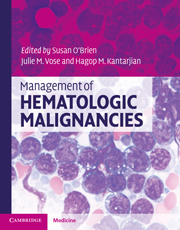Book contents
- Frontmatter
- Contents
- List of contributors
- 1 Molecular pathology of leukemia
- 2 Management of acute myeloid leukemia
- 3 Treatment of acute lymphoblastic leukemia (ALL) in adults
- 4 Chronic myeloid leukemia
- 5 Chronic lymphocytic leukemia/small lymphocytic lymphoma
- 6 Myelodysplastic syndromes (MDS)
- 7 Hairy cell leukemia
- 8 Acute promyelocytic leukemia: pathophysiology and clinical results update
- 9 Myeloproliferative neoplasms
- 10 Monoclonal gammopathy of undetermined significance, smoldering multiple myeloma, and multiple myeloma
- 11 Amyloidosis and other rare plasma cell dyscrasias
- 12 Waldenstrom's macroglobulinemia/lymphoplasmacytic lymphoma
- 13 WHO classification of lymphomas
- 14 Molecular pathology of lymphoma
- 15 International staging and response criteria for lymphomas
- 16 Treatment approach to diffuse large B-cell lymphomas
- 17 Mantle cell lymphoma
- 18 Follicular lymphomas
- 19 Hodgkin lymphoma: epidemiology, diagnosis, and treatment
- 20 Treatment approaches to MALT/marginal zone lymphoma
- 21 Peripheral T-cell lymphomas
- 22 Mycosis fungoides and Sézary syndrome
- 23 Central nervous system lymphoma
- 24 HIV-related lymphomas
- 25 Lymphoblastic lymphoma
- 26 Burkitt lymphoma
- Index
- References
12 - Waldenstrom's macroglobulinemia/lymphoplasmacytic lymphoma
Published online by Cambridge University Press: 10 January 2011
- Frontmatter
- Contents
- List of contributors
- 1 Molecular pathology of leukemia
- 2 Management of acute myeloid leukemia
- 3 Treatment of acute lymphoblastic leukemia (ALL) in adults
- 4 Chronic myeloid leukemia
- 5 Chronic lymphocytic leukemia/small lymphocytic lymphoma
- 6 Myelodysplastic syndromes (MDS)
- 7 Hairy cell leukemia
- 8 Acute promyelocytic leukemia: pathophysiology and clinical results update
- 9 Myeloproliferative neoplasms
- 10 Monoclonal gammopathy of undetermined significance, smoldering multiple myeloma, and multiple myeloma
- 11 Amyloidosis and other rare plasma cell dyscrasias
- 12 Waldenstrom's macroglobulinemia/lymphoplasmacytic lymphoma
- 13 WHO classification of lymphomas
- 14 Molecular pathology of lymphoma
- 15 International staging and response criteria for lymphomas
- 16 Treatment approach to diffuse large B-cell lymphomas
- 17 Mantle cell lymphoma
- 18 Follicular lymphomas
- 19 Hodgkin lymphoma: epidemiology, diagnosis, and treatment
- 20 Treatment approaches to MALT/marginal zone lymphoma
- 21 Peripheral T-cell lymphomas
- 22 Mycosis fungoides and Sézary syndrome
- 23 Central nervous system lymphoma
- 24 HIV-related lymphomas
- 25 Lymphoblastic lymphoma
- 26 Burkitt lymphoma
- Index
- References
Summary
Introduction
Waldenstrom's macroglobulinemia (WM) is a distinct clinicopathologic entity resulting from the accumulation, predominantly in the bone marrow, of clonally related lymphocytes, lymphoplasmacytic cells, and plasma cells which secrete a monoclonal IgM protein (Figure 12.1). This condition is considered to correspond to the lymphoplasmacytic lymphoma (LPL) as defined by the Revised European–American Lymphoma (REAL) and World Health Organization (WHO) classification systems. Most cases of LPL are WM, with less than 5% of cases made up of IgA, IgG, and non-secreting LPL.
Epidemiology and etiology
WM is an uncommon disease, with a reported age-adjusted incidence rate of 3.4 per million among males and 1.7 per million among females in the USA, and a geometrical increase with age. The incidence rate for WM is higher among Caucasians, with African descendants representing only 5% of all patients. Genetic factors appear to be an important factor to the pathogenesis of WM. Approximately 20% of WM patients have an Ashkenazi (Eastern European) Jewish ethnic background, and there have been numerous reports of familiar disease, including multigenerational clustering of WM and other B-cell lymphoproliferative diseases. In a recent study, approximately 20% of 257 serial WM patients presenting to a tertiary referral had a first-degree relative with either WM or another B-cell disorder. Frequent familiar association with other immunologic disorders in healthy relatives, including hypogammaglobulinemia and hypergammaglobulinemia (particularly polyclonal IgM), autoantibody (particularly to thyroid) production, and manifestation of hyperactive B cells have also been reported.
- Type
- Chapter
- Information
- Management of Hematologic Malignancies , pp. 207 - 227Publisher: Cambridge University PressPrint publication year: 2010



